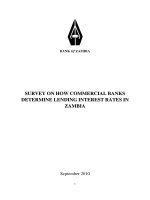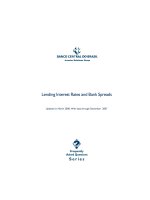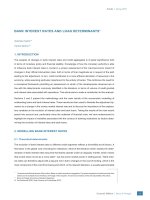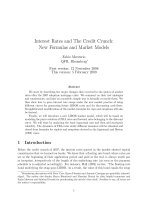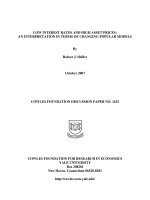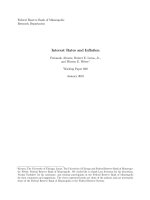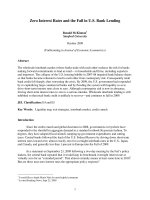- Trang chủ >>
- Cao đẳng - Đại học >>
- Luật
REGULATIONS ON LENDING INTEREST RATES AND PRACTICAL APPLICATION
Bạn đang xem bản rút gọn của tài liệu. Xem và tải ngay bản đầy đủ của tài liệu tại đây (1.08 MB, 74 trang )
MINISTRY OF EDUCATION AND TRAINING
HO CHI MINH CITY UNIVERSITY OF LAW
-----------***-----------THE MANAGING BOARD OF
SPECIAL TRAINING PROGRAMS
LE THI KHANH LINH
REGULATIONS ON LENDING INTEREST
RATES AND PRACTICAL APPLICATION
BACHELOR THESIS
Faculty of Commercial Law
Course: 37 (2012-2016)
HO CHI MINH CITY
2016
MINISTRY OF EDUCATION AND TRAINING
HO CHI MINH CITY UNIVERSITY OF LAW
-----------***-----------THE MANAGING BOARD OF
SPECIAL TRAINING PROGRAMS
LE THI KHANH LINH
REGULATIONS ON LENDING INTEREST
RATES AND PRACTICAL APPLICATION
BACHELOR THESIS
Faculty of Commercial Law
Course: 37 (2012-2016)
Supervisor: Ph.D Ha Thi Thanh Binh
Author: Le Thi Khanh Linh
Student code: 1155010514
Class: CLC37B
HO CHI MINH CITY
2016
ACKNOWLEDGEMENT
This bachelor thesis with the topic “Regulations on lending interest rates
and practical application” has been researched and written with all my efforts at
University of Law.
First of all, I would like to sincerely want to acknowledge supports from my
supervisor, Ph.D. Ha Thi Thanh Binh. She devoted a lot of guidelines to instruct
and supervise my thesis. Furthermore, I am grateful to Associate Professor, Ph.D.
Do Van Dai for his judgments supply on the topic.
Secondly, I would like to send all my love to my family owing to theirs
encourages.
Last but not least, I am truly thankful to all of my teachers and my friends,
who are beside me and help me in various ways.
DECLARATION
I hereby declare that the thesis “Regulations on lending interest rates and
practical application” is the consequence of my own study under the supervisor of
Ph.D. Ha Thi Thanh Binh. I ensure the authenticity and the compliance with reference
regulations, all of the information other than my opinions to be used or quoted has been
acknowledged by means of complete references. In case of infringement, I shall bear
all of the responsibility.
Ho Chi Minh, 19 July 2015
Le Thi Khanh Linh
CONTENTS
DECLARATION
INTRODUCTION
Chapter 1
1.1
1.1.1
Overview of regulations on interest rates in loan agreements ......... 1
Some fundamental concepts...................................................................... 1
Overview of loan agreements ............................................................... 1
1.1.1.1
Definition .......................................................................................... 1
1.1.1.2
Characteristics of a loan agreement .................................................. 2
1.1.2
Overview of interest rates ..................................................................... 5
1.1.2.1
From economic aspect ...................................................................... 5
1.1.2.2
From the legal aspect ........................................................................ 7
1.2
1.2.1
Characteristic of lending interest rates ...................................................... 7
The interest rate in loan agreement is resulted from voluntary
negotiations pursuant to laws. .............................................................................. 7
1.2.2
The lending interest rate is “a specific price” in comparison with other
prices of goods ...................................................................................................... 9
1.2.3
The lending interest rate always depends on the type, time limit and
purpose of use ..................................................................................................... 11
1.2.4
The lending interest rate is always influenced by other interest rates 11
1.2.4.1
The lending interest rate and the deposit interest rate..................... 12
1.2.4.2
The lending interest rate and the prime/base interest rate............... 13
1.2.4.3
The lending interest rate and the re-financing interest rates, the re-
discount interest rates ......................................................................................... 13
1.2.4.4
1.3
The lending interest rate and inter-bank offered rate ...................... 14
Factors which have effect on lending interest rates ................................ 15
1.3.1
Supply and demand ............................................................................. 15
1.3.2
Inflation ............................................................................................... 16
1.4
Classification of interest rates ................................................................. 17
1.4.1
Based on the nature of the loan: .......................................................... 17
1.4.2
Based on the real value of the interest earned ..................................... 18
1.4.3
Based on the flexibility of interest rate ............................................... 19
1.4.4
Based on type of currency in lending.................................................. 19
1.4.5
Based on domestic or international sources of credit ......................... 20
1.5
Regulations on interest rates ................................................................... 20
1.5.1
Term interest rates ............................................................................... 20
1.5.2
Preferential interest rates ..................................................................... 23
1.5.3
Overdue interest rates .......................................................................... 25
1.5.4
Remedies for violations of lending interest rates ................................ 27
1.5.4.1
Civil sanction: ................................................................................. 27
1.5.4.2
Administrative sanctions: ................................................................ 28
1.5.4.3
Criminal sanctions: ......................................................................... 28
Chapter 2
Practical apPlication of regulations on lending interest rates and
some recommendations ...................................................................................... 30
2.1
2.1.1
Practical application of regulations on lending interest rates ................. 30
Practical application of regulations on term interest rates .................. 30
2.1.1.1
Interest rates as agreed by the parties and case where lending interest
rates exceed the ceiling interest rate ................................................................... 30
2.1.1.2
Determination of interest rates when the borrowers fall into the state
of bankruptcy ...................................................................................................... 33
2.1.1.3
2.1.2
2.1.2.1
Determining a point of time to calculate interest rates ................... 34
Practical application of regulations on preferential interest rates ....... 36
Practical application of regulations on preferential interest rates of
stipulating provision of loan for housing assistance .......................................... 36
2.1.2.2
Practical application of regulations on preferential interest rates of
personal installment loans .................................................................................. 39
2.1.2.3
Practical application of regulations on preferential interest rates of
other policies of State ......................................................................................... 40
2.1.3
Practical application of regulations on overdue interest rates ............ 41
2.1.4
Practical application of regulations on sanctions for violations of
lending interest rates ........................................................................................... 45
2.1.4.1
Practical application of civil sanctions: .......................................... 45
2.1.4.2
Practical application of administrative sanctions:........................... 46
2.1.4.3
Practical application of criminal sanctions ..................................... 47
2.2
Some recommendations to improve effectiveness of current regulations on
interest rates ........................................................................................................ 48
2.2.1
Term interest rates ............................................................................... 49
2.2.2
Preferential interest rates ..................................................................... 50
2.2.3
Overdue interest rates .......................................................................... 50
2.2.4
Regulations on punishment for violations of lending interest rates .... 51
2.2.4.1
Civil sanctions ................................................................................. 51
2.2.4.2
Administrative sanctions ................................................................. 51
2.2.5
Criminal sanctions ............................................................................... 52
CONCLUSION .................................................................................................. 54
REFERENCES
APPENDIX
INTRODUCTION
1. Rational of the thesis
Along with the economic development, the demand of capitals significantly
increases with the purpose of business operations, as a result, the credit institutions,
which play as capitals supply channel in this market, and are chosen by many
organizations and individuals in lack of cash. As general, the form of lending
between the credit institutions and individuals, organizations are loan agreements
with many provisions as agreed by both parties. Lending interest rates are deemed
as the most important issues in loan agreements because they affects directly to
profits of each party.
Besides being adjusted by Civil Code 2005, the lending of the credit
institutions is also adjusted by specific law. So, there are some troubles occurred to
the courts when making decisions in lending interest rates whether applying
specific law or Civil Code. Most of the credit institutions prefer applying specific
law in determining lending interest rates because they would obtain more profitable
interest than applying provisions prescribed in Civil Code 2005. It means that
borrowers will suffer higher lending interest rates if the lenders rule to pursuant to
specific law in loan agreements, which causes the conflict of interest of the
borrowers and the lenders when having dispute settlements relating to deciding
interest rates.
As regulated in Article 2.3 of the Law on the State Bank (Law No.
46/2010/QH12), “The State Bank performs the state management of monetary,
banking and foreign exchange (below referred to as monetary and banking)
operations and performs the function of a central bank in issuing money, a bank of
credit institutions and a provider of monetary services for the Government”, there
are three functions of the State Bank listed in this Article, so the State Bank plays as
a core to manage monetary policy to guarantee monetary security in society. The
management of lending interest rates is considered as an efficient tool for the State
Bank to perform its functions. However, the current legislation on lending interest
rates still has “gaps” to fulfill in banking law field, the author decided to study this
topic due to its shortcomings in legislation results in different views of courts when
having lending interest rate disputes. Essentially, the author would like to give out
some recommendations to improve the effectiveness of current regulations on
interest rates.
2. State of research affairs
In general, lending interest rates, which are not new issues, has been
discussed in many workshops or studied in many respects because of its important
functions in the economic integration. To the extent of the thesis conducted at Ho
Chi Minh University of Law, there are researches on lending interest rates;
“Lending interest rates disputes in loan agreements – Practical application and
solutions” is the graduation thesis of Pham Le Ninh, the author Dang Thi Nga with
a bachelor thesis titled “Legislation on interest rates in loan agreements” and a
work titled Law on lending interest rates of the credit institutions of Pham Thi Le
Ha are conducted in 2010. After that time, the thesis of Le Thi Thu Hien:
“Regulations on managing interest rates of the State Bank” also did researches on
interest rates; however, all works mentioned above just focus on analyzing theories
of interest rates and/or discuss interest rates disputes in frame of Civil Code 2015
has not promulgated, so they are not suitable with the current situation.
In 2015, the thesis of Nguyen Thi Anh Tran: “Practical application of
lending interest rate in credit contracts” introduced the overview of lending interest
rates and some cases relating to interest rates disputes at that time. However, this
thesis did not update the changes of regulations on lending interest rates in draft of
Civil Code 2015 and Criminal Code 2015, the thesis is merely a reference for
people want to study case at that time.
Furthermore, there have been a lot of articles and workshops concerning this
issue recently; such as some articles as follows: “Problems in the application of
laws on interest rates in credit contracts and loan contracts” of Doan Duc Luong,
“Applying regulations on lending interest rates appropriately in settling disputes”
of Luong Khai An, etc, gave out briefly shortcomings of interest rates in loan
agreements.
Within the scope of the thesis, the author would like to combine regulations
and practices application of lending interest rates with the purposes of:
Introducing the overview of regulations on interest rates in loan agreements;
Clarifying the conflicts and shortcomings of regulations on interest rates in
loan agreements by citing judgments and loan agreements;
Suggesting recommendations to improve effectiveness of current regulations
on interest rates.
3. Objectives and scopes of the thesis
3.1 Objectives
To the extent of the thesis, the author focuses on giving out some
fundamental concepts relating to interest rates in loan agreements, which is
basically utilized to acquaint readers with the regulations on lending interest rates.
Besides, the author clarifies the problems of determining interest rates in practice,
after that, the author states the conflicts when applying Civil Code 2005 and
specific law in lending interest rates. Moreover, some cases or loans agreements are
cited in the thesis so as to make out the practical application to support for the
recommendations.
3.2 Scopes
The thesis is restricted within:
Regulations on interest rates in loan agreements signed between the credit
institutions and individuals, organizations in Vietnam.
Some cases relating to determination of lending interest rates in loan
agreements will be used as a mean to clarify the inappropriate regulations on
this issue.
The author’s recommendations to improve effectiveness of current
regulations on lending interest rates.
4. Methodology of the thesis
The lending interest rates in the thesis, which is analyzed in detail, based on
both regulations of laws and practice. Therefore, the author uses methods of
analysis, list, comparison, and conclusion to construct this work.
5. Structure of the thesis
Besides the Table of Content, the Abbreviation, the Reference, the
Introduction and the Conclusion, the thesis is split into two chapters:
Chapter 1: Overview of regulations on interest rates in loan agreements.
Chapter 2: Practical application of regulations on lending interest rates and
some recommendations.
CHAPTER 1
OVERVIEW OF REGULATIONS ON INTEREST RATES
IN LOAN AGREEMENTS
1.1 Some fundamental concepts
1.1.1 Overview of loan agreements
1.1.1.1 Definition
In this economic integration, the demand for capital of individuals and
organizations through loan agreements is quite common. Loan agreements which are
regulated in both Civil Code and specialized laws, for the extend of this thesis, the
author just focuses on loan agreements signed between credit institutions (like banks,
non-bank credit institutions, microfinance institutions and people's credit funds) and
other subjects. So, the definition of loan agreements in this thesis is restricted in
banking law which makes us deeply analysis and easily in putting forward personal
opinions about lending interest rates.
In general, credit relationship is naturally supposed to be a part of civil
relationship, therefore, loan agreements between credit institutions and individuals and
organizations (“loan agreements”) are specific types of contracts for property loan
which are provided in Civil Code 20051. Loan agreements, which are legal bases for
credit institutions put into action lending operations, are contracts in writing between
credit institutions and organizations, individuals are eligible by law, “under which
credit institutions (the lenders) give or commit to give organizations, individuals (the
borrowers) a sum of money for use for a specific purpose in a certain period as agreed
upon on the principle of payment of both principal and interest”2.
After having done an analysis on credit, credit institutions assume that whether
their customer has both economic viability and solvency, they will reach a loan
agreement in writing. Such loan agreement “must stipulate the loan conditions, the
1
See Article 471, Civil Code 2005: “A contract for property loan is an agreement between the parties
whereby the lender transfers the property to the borrower; when the loan is due, the borrower must return to the
lender the property of the same type in the same quantity and of the same quality, and shall have to pay the
interest only if so agreed upon or provided for by law”.
2
See Ho Chi Minh University of Law (2010), Banking Law Textbook, National University Publishing
House in HCM City, page 235.
1
purpose of loan utilization, the method of lending, the loan amount, the interest rate,
the loan term, the form of loan security, the value of security assets, the method of
repayment, and the other undertakings agreed by the parties”3.
Banking law has no provision to give the meaning of a loan agreement, they just
provide terms that a loan agreement must have. In general, a loan agreement is a legal
document determining the relationship between banks and customers, under the terms
of an agreement, between the parties on the rights and obligations in the process of
utilization and repayment.
1.1.1.2 Characteristics of a loan agreement
Loan agreements also have general characteristics of civil contracts, besides,
they also have special criteria as follows:
Firstly, the lenders of loan agreements are always credit institutions, pursuant
to Law on Credit institutions: “Credit institutions include banks, non-bank credit
institutions, microfinance institutions and people's credit funds” 4. The lenders may be
one or more than one credit institution (in case of syndicated lending) and satisfy
certain statutory conditions, which are established and operating under the Law on
Credit institutions and the relevant documents.
Secondly, loan agreements must be executed in written form.
The purpose of the borrowers is to get loans, whereas, the lenders’ purposes are
to minimize the risks of lending and collect interest rates from lending. So the best
thing is parties shall reach an agreement in writing, with detail provisions regulate
rights and obligations of each party. Such agreements play an important role in making
sure that no party can refuse its duties because these are legal bases to settle disputes.
3
See Article 17, Decision No. 1627/2001/QD-NHNN of the Governor of the State bank of Vietnam on
December 31, 2011 on issuing regulations on lending by credit institutions to clients.
4
See Article 4.1, Law No. 47/2010/QH12 promulgated by the National Assembly on June 16, 2010 on
Credit institutions.
2
Especially, it is authorized the parties to reach loan agreements in both written
forms and data messages5, which have similar legal validity in practice, used as
evidences of the transaction process6. It may be considered to be a significant effort of
the lawmakers to stipulate the loan agreements, which must be concluded in writing
and with the acceptance of both forms mentioned above, ensure the legal validity of the
loan agreements.
The loan agreements, as usual, are model agreements created in accordance with
the provisions of law and regulations on lending by the credit institutions. The specific
provisions in the agreement are to stipulate rights and obligations of the borrower and
the lender. When the parties have agreed upon the specific rights and obligations, they
must comply with their commitments. If either party breaches commitments and cause
damage to the other party, they shall be responsible for compensation for the losses that
other party has to suffer. Thus, when a dispute occurs, the loan agreement is a basis to
protect the parties’ rights.
Thirdly, a monetary capital is the object of the loan agreements is always.
The monetary capitals in the loan agreements can be Vietnam dong, foreign
currencies or gold. The monetary capital, as a mean of payment instrument - most
important role of the currency, can meet the needs of the borrowers (such as the loan
amount and loan purposes) in the simple manners; whereupon, it is an important
characteristic in lending relation of the credit institutions that makes lending become a
substantial business activity and a favored banking operation in this economic
integration. If the objects of the credit relationships between the credit institutions and
the borrowers are properties, which is called financial leasing relationships by
signing financial leasing contracts, not lending activities. In principle the objects of the
loan agreements are always a fixed amount of money, concurred by the parties and
specified in such agreements.
Fourthly, the loan agreements must adhere to the statutory conditions
prescribed by law.
5
See Article 4.12, Law on E-transactions: “A data message means information created, transmitted, received
and stored by electronic means”.
6
See Article 124.1, Civil Code 2005; Article 11, 12, 13, Law on E-transactions.
3
These statutory conditions include the following capacity of parties in the credit
relationships, loan purposes, loan terms, lending limits, etc. The credit institutions must
not loan with the objects of satisfy the prohibited needs according to the laws, such as:
to procure assets and for costs which will form assets the purchase and sale, transfer
or disposal of which is prohibited by law, to make payment for transactions which are
prohibited by law, to satisfy financial requirements of transactions which are
prohibited by law7, and to buy gold, except for the case of being accepted by the
Governor of the State Bank to fund for buying gold to produce gold bar, produce and
handle golden jewelry, fine arts and lend for importing gold materials in accordance
with license of the State Bank8.
In addition, the credit institutions may not provide loans to the following clients:
members of the board of management or inspection committee, the general director
(director) or deputy general director (deputy director) of the credit institution; staff of
the credit institution who carry out loan evaluation and approval; parents, spouses or
children of the members of the board of management or inspection committee, of the
general director (director) or deputy general director (deputy director)9, however, the
credit institutions may consider and decide whether or not to apply this provision to
lending to the parents, spouses or children of the director or deputy director of a
branch.
Generally, as a guarantee instrument of rights and obligations for the parties
involved in credit relationship, the loan agreement becomes central in doing business
between credit institutions and their clients. Commonly, the parties shall pay intentions
to the content of the loan agreement, which expressly runs into many brevity clauses
and is devoted more time to draft in order to make parties observe strictly, also prevent
one party from claiming the loan agreement null and void. Thereof, the loan
agreements with the severe provisions will bind the parties to comply with their
7
See Article 9, Regulations on lending by credit institutions to clients (Issued with Decision 1627-2001QD-NHNN1 of the Governor of the State bank dated 31 December 2001).
8
See Article 2, Circular of the State bank of Vietnam amending, supplementing some Articles of the
Circular No. 13/2010/TT-NHNN dated May 20, 2010 of the State Bank of Vietnam stipulating prudential ratios
in operations of credit institutions and Regulations on lending by credit institutions to clients issued with the
Decision 1627/2001/QD-NHNN dated December 31, 2001 of the Governor of the State Bank.
9
See Article 19, Regulations on lending by credit institutions to clients (Issued with Decision 16272001-QD-NHNN1 of the Governor of the State Bank dated 31 December 2001).
4
obligations, thereby also contributing to the reduction of disputes arising, and promote
the development of business activities.
Especially, lending interest rates, which invariably incorporate completed loan
agreements, are particularly concerned by the parties when they reach to the
agreements. Moreover, this might well be said if both the lender and the borrower are
consensus on lending interest rates and seriously implement obligations on interest
rates, the loan agreements shall be successful in effect.
1.1.2 Overview of interest rates
In modern times, interest rate is deemed as an important tool to manage
economic market because it has a close relationship with economic interests of each
person in our society. Further, the rate of interest has effects on personal determination
like: expense, savings for investment. As well, the interest rate changes can result in a
change of every business decision of corporations, they have to consider whether
loaning to expand production or lending capital to get interest and which is the most
profitable they can get when laying out money on. Needless to say, through the
decisions of individuals, businesses, interest rates affect the level of development and
economic structure of the country.
In sum, the rate of interest influences are significant, so many scholars have
carried out extensive researches on from both economic aspect and legal aspect.
1.1.2.1 From economic aspect
Interest rate is a payment made by a borrower to the lender for the money
borrowed and is expressed as a rate percent. It is usually expressed as an annual rate in
term of money and is calculated on the principal of the loan. It is the price paid for the
use of other’s capital fund for a certain period of time.
Keynes, a 19th-century British philosopher and economist, is known as the
father of Keynesian economics, stated in a paper titled "The General Theory of
Employment, Interest and Money” that “…the rate of interest at any time, being the
reward for parting with liquidity, is a measure of the unwillingness of those who
possess money to part with their liquid control over it. The rate of interest is not the
“price” which brings into equilibrium the demand for resources to invest with the
5
readiness to abstain from present consumption”10. The rate of interest, whereby, is not
an income for savings because the capitals will not get any interest even though the
amount of cash will increase day by day. There are two factors, which have influences
on the rate of interest, as claimed by Keynes in his work named “Alternative theories
of the rate of interest”, are “the present supply of money” and “the demand schedule
for a present claim on money in term of a deferred claim on money” 11. With the
former, which is supply of money, he affirmed that when the amount of money in
circulation enhances, the interest rate will undoubtedly decrease and vice versa, in
another word, if the supply of cash grows, at the same time as the demand remains the
same or not keeps pace with the rise in the number of the supply of cash, which leads
to the decrease of the interest rate. With the latter is the interest in cash, he said that the
properties of each person existed in many forms, but money is the most convenient
form, hence, people tend to be associated with it. The interest of rate is the reward for
parting with liquidity, a measure of the unwillingness of those who possess money to
part with their liquid control over it. Also, Keynes claimed that the interest rate is
psychological phenomenon, means that: if people have belief in the interest rate is
prolonged, it will be12. The theory of the interest rate of Keynes, in sum, implied
clearly about the nature of the interest rate, which is a specific price for purchasing the
right of using cash for a certain period.
In addition, Mashall supposed that – “The payment made by borrower for the
use of loan is called interest”, besides, according to Richard, “Interest is primarily a
reward for waiting”. But the modern economist in order to avoid the divergent and
controversial views about the interest rate, have explained it in term of productivity,
saving, liquidity and money. In other words, the interest rate is the reward for yield of
capital, of saving, for the foregoing of liquidity and the supply of money. Thus, they
have explained it in term of the demand and supply of money13.
10
See John Maynard Keynes The General Theory of Employment, Interest and Money,
accessed on 12 June
2016.
11
See accessed on 12 June 2016.
12
See University of National Economy (2003), The history textbook economic theory, Statistics
Publishing House, Hanoi, page.222 (Trường Đại học kinh tế quốc dân (2003), Giáo trình lịch sử các học thuyết
kinh tế, NXB Thống kê, Hà Nội, tr.222).
13
See accessed on 14 June 2016.
6
1.1.2.2 From the legal aspect
The interest rate is adjusted by many different legislative documents.
Notwithstanding, there is no statutory definition of the interest rate in general or the
interest rate in loan agreements in particular. The rate of interest has just mentioned in
Civil Code, in Section 4 - Contracts for property loan, Article 12.1 of Law on the State
Bank and Article 91.2 of Law on Credit institutions. Regulations on lending by credit
institutions to clients (Issued with Decision 1627-2001-QD-NHNN1) also has no
definition of the rate of interest in the loan agreement. They just have just regulated on
how to adjust the interest rate, from this performed the role of laws on lending in our
society.
Although, economic sense and legal sense have their own concepts of the rate of
interest, as mentioned above, it might be seen the nature of the interest rate is the profit
obtained through lending of credit institutions. Nevertheless, considering from any
aspects, it is undeniable that the interest rate is a profit, which the credit institutions
get, helping offset costs of operation, establishing risk provision and making profits for
the credit institutions. In addition, the interest rate is an instrument to control the
national monetary policies.
Sum up, the interest rate in the loan agreement is normally used in specific
relationship, which is lending relationship between clients and the credit institutions.
This relationship has its own characteristics and will be clarified in Section 1.2 below.
1.2 Characteristic of lending interest rates
1.2.1 The interest rate in loan agreement is resulted from voluntary negotiations
pursuant to laws.
“A civil contract is an agreement between the parties to establish, change or
terminate civil rights and/or obligations”14, also, a civil contract is the forms containing
what the parties negotiated voluntarily. The same as the civil contract, the loan
agreement is signed on the ground of restricted legal negotiations in the rate of interest.
These negotiations of the interest rate, which have to be observed to regulations, are
14
See Article 388 of Civil Code 2005.
7
restricted elements. Nevertheless, in practice, the interest rates are governed by the
credit institutions and fixed to each group of the clients of the credit institutions
because in this relationship, the borrower is under circumstance of shortage of capital,
whereas, the lender, who has available capital, has “the power in rescuing the
borrower”. So, the lender is likely to have more advantages in the loan agreements than
the borrower, that explains the reason why most of the loan agreements between the
credit institutions and their clients have terms of the interest rates do not depend on the
bargains, instead, the credit institutions often intentionally issue the rate of lending
interest to each of their clients and the clients have fewer opportunities to renegotiate
the interest, they just have two options: either accepting that interest rate and the
lenders will disburse the amount of money or disagree with that rate and no contract
will be reached.
There are a few cases that the borrowers make the lenders feel that they are
prestigious enough to have reliability which bring them chances to bargain the lending
interest. In theory of the contracts, the lending interest always has the nature of the
negotiations. In a contract for purchase and sale, both parties have rights to bargain all
the terms and the price of that contract, they almost have no restrict in dealing prices.
The different situation appears in the loan agreement when the clients would like to
negotiate the lending interest, they have to follow regulations and laws which have
issue in that rate. Their loan agreement will be invalid if they break the laws and they
themselves give out the lending interest over the ceiling interest rate, below the floor of
interest rate or do not obey other regulations relating to the interest rate.
The policies of controlling the lending interest rate of the State Bank are
different in each period. Currently, the State Bank has issued the basic interest rate,
which is nine percent per year, to adjust the lending activities of the credit institutions.
This basic interest rate may be called “legal barrier” governed by the authorities. As
regulated in Article 476.1 of Civil Code 2005: “The lending interest rate shall be
agreed upon by the parties, but must not exceed 150% of the basic interest rate
announced by the State Bank for loans of the corresponding type”, the authorities
manage the lending through many activities, one of them is the lending interest rate,
which has enormous effect in assist the Government perform the uniform state
management of banking operations throughout the country, also form the propensity
for the credit institutions compete fairly in the lending activity.
8
The rate of interest in the lending has been changed in new Civil Code 2015, are
going to be valid from the date 1 January 2017: “The rate of interest for a loan shall be
as agreed by the parties. The rate of interest for a loan agreed by the parties may not
exceed 20% per year, unless otherwise prescribed by law. According to actual
conditions and at the proposal of the Government, the Standing Committee of National
Assembly shall adjust the above interest and send report to the National Assembly at
the latest session. If the agreed interest exceeds the maximum interest prescribed in
this Clause, the agreed interest shall become invalid”, this clause of Article 468 of the
Civil Code 2015 emphasizes the negotiations of the lending interest, besides, it gives
out the maximum rate that both parties have to follow in order not to be declared
invalid the excess.
In addition, the Article of interest rate of the Civil Code 2015 has clarified two
cases; firstly, when both parties agree the specific lending interest rate15; secondly,
when both parties agree that interest will be payable but fail to specify the interest rate,
or where there is a dispute as to the interest rate16. Two cases mentioned are likely to
be more detail and easy in apply in practical because this clause divided into different
cases.
The characteristic of the lending interest rate is mainly focused on the restricted
agreement between the lender and the borrower following the regulations and relating
laws. This means that this is not the only one characteristic, there are many feature
which will be analyzed below.
1.2.2 The lending interest rate is “a specific price” in comparison with other prices of
goods
The lending is considered as selling specific goods, which is cash and the
interest of this selling activity is a price of that goods. In comparison with other prices
of good in market, the lending interest rate is a particular price because of it has these
following criteria:
15
See Article 468.1 of Civil Code 2015.
See Article 468.2 of Civil Code 2015: “Where parties agree that interest will be payable but fail to
specify the interest rate, or where there is a dispute as to the interest rate, the interest rate for the duration of the
loan shall equal 50% of the maximum interest prescribed in Clause 1 of this Article at the repayment time.”
16
9
Firstly, the lending interest rate is the price of distinguishing goods, which is a
monetary capital, in other words, it is cash, which contains many significant functions
such as mean of payment, value measure instrument, mean of transfer, mean of storage.
These functions make monetary capitals become specific goods. As noted, value
measure instrument is a fundamental of money, through its value to measure and
express value of other goods, to transfer the value of goods to be the price of goods 17.
The next function of money is means of transfer with the recipe for making the transfer
below:
G (goods) – M (money) – G (goods)
In fact, in the opinion of Karl Marx, he affirmed that money was the mediator in
circulation of good, money took a mean of transfer. Furthermore, the roles of mean of
storage and mean of payment of cash are also important; monetary capital contains
both economy category and society category; currency is not merely a senseless
commodity, but also contains sense, expressed in its many complicated social
relationship.
Thus, in the correlation between currency and other goods, currency is unique
goods, which results in its price, is dissimilar to the prices of the others.
Secondly, commodity prices are intentionally given by the manufacturer,
depend on the calculation of the expenses of production, shipment and so forth. Each
company has its own business strategies and the authorities do not have further
interventions in business activities of the manufacturers. Sometimes, the same kind of
goods but have different prices from different manufacturers, it means that the prices of
good is basically various, with no maximum or minimum restriction on the goods
prices, whereas, the lending interest rate is the price of specific goods, which “is
produced” by “the monopoly manufacturer” named the State Bank18. There is whereby
17
See Nguyen Dang Don (2009), Monetary Banking, National University Publishing House, HCMC,
page 13 “value measurement function is the most basic function of the currency, through its values to measure
and expression values for other commodities, the value of goods transformed into commodity prices”. (Nguyễn
Đăng Dờn (2009), Tiền tệ Ngân Hàng, NXB Đại học Quốc gia, TP HCM, tr 13 “Chức năng thước đo giá trị là
chức năng cơ bản nhất của tiền tệ, thơng qua giá trị của mình để đo lường và biểu hiện giá trị cho các hàng hóa
khác, chuyển hóa giá trị hàng hóa thành giá cả hàng hóa”).
18
See Article 2.3, Law on the State Bank of Viet Nam 2010: “The State Bank performs the state
management of monetary, banking and foreign exchange (below referred to as monetary and banking) operations
and performs the function of a central bank in issuing money, a bank of credit institutions and a provider of
monetary services for the Government”.
10
no variety in the lending interest rate as the other goods prices. The interest rate just
fluctuates in a certain range, sometimes, it is a fixed number. Especially, the rate of
interest, which does not include the production expenses and is adjusted strictly by the
authorities, is an effective tool to assist the authorities to regulate the economy of the
country in line with the goals and strategies set out.
Last but not least, the lending interest rate is not merely the price of the specific
goods, but also plays as a criterion for evaluating the stability of the currency market
and the economy. Through the lending interest, the borrowers can know the price of
loans and they will consider making decisions whether or not to borrow loans, further,
it also reflects the development of the country or even this of the world. In sum, the
unique criteria of the lending interest rate make it has its own specific regulations in
lending activities.
1.2.3 The lending interest rate always depends on the type, time limit and purpose of
use
The lending interest rate will be different if the type is foreign currency or
Vietnam dong, because the policies of each currency are not the same.
Time limit of the loan is proportional to the lending rates. The longer the loan
duration, the higher the interest rates, because the loan term associated with the risk
that the lender may incur.
The purposes of using the amount of money prove that the borrower’s ability in
creating loans for the economy and have risks relationship in repaying of the
borrowers. Therefore, with the different purposes will be applied different the rate of
interest.
In general, the credit institutions do not separate three elements as mentioned
above to determine the lending interest rate.
1.2.4 The lending interest rate is always influenced by other interest rates
In current market, beside the lending interest, there are deposit interest rates,
prime interest rates, re-financing interest rates, discount interest rates, re-discount
interest rates, inter-bank interest rates, etc. Principally, there are binding connections
11
between the lending interest and the others. Hence, when analyzing deeply the nature
of the lending interest, we shall put it in the correlations of the others interest.
1.2.4.1 The lending interest rate and the deposit interest rate
These two types of interest have close relationship, which is the basic for the
commercial banks to determine their profits in currency trading. The deposit interest
rate is associated with capital raising of the credit institutions. The capital raising is one
of the most important services of each credit institution because the credit institution is
known as a financial mediator borrowing to make loans. The raise of capital of the
credit institution is conducted by many methods like: taking demand deposits, time
deposits, savings deposits and deposits of other types19; issuing deposit certificates,
promissory notes, treasury bills and bonds to raise capital at home and aboard20;
borrowing of loans from the State Bank21 or borrowing of loans from credit institutions
and financial institutions22; etc.
In one way, the deposit interest is similar to the lending interest, however, with
deposit interest, the lenders are the depositors, and the credit institutions are the
borrowers. This means that in this case, the party, who has obligation to pay for interest
agreed in the loan contracts, is the credit institutions.
Basically, the credit institutions have two functions, firstly, they are the
borrowers in raising capital relationship, and secondly, they are the lenders in credit
extension relationship. In the principle of banking services, when there is a rise in the
deposit interest rates will lead to an increase in the lending interest rates, and vice
versa. Extraordinarily, the credit institutions make loans with a lower interest rate than
the deposit interest rate. Obviously, all the commercial banks desire to have more
depositors and remain the stability of taking deposits activity by increasing the deposit
interest rates, on the other hand, they would like to reduce the deposit interest rates
because they do not want to cut down potential income, which explains the reason why
19
See Article 98.1 of the Law on the Credit institutions.
See Article 98.2 of the Law on the Credit institutions.
21
See Article 99 of the Law on the Credit institutions: “Commercial banks may borrow loans from the
State Bank in the form of re-financing under the Law on the State Bank of Vietnam”.
22
See Article 100 of the Law on the Credit institutions: “Commercial banks may borrow loans from
domestic and overseas credit institutions and financial institutions under law”.
20
12
the commercial banks try to maintain profit levels appropriately for themselves by
estimating the difference between lending rates and deposit rates.
1.2.4.2 The lending interest rate and the prime/base interest rate
Generally, the prime interest rates are declared by the State Bank “to serve the
regulation of the monetary policy and the fight against usury” 23. The prime interest rate
is considered as the basis for all other interest rates have reference to apply or rely on it
to adjust. The prime interest rate is regarded as the main rate in giving directions for
the credit institutions conduct their lending activity adhere to the regulations.
As regulated in the Civil Code 2005, the prime interest rate plays an important
role in determine the interest in lending activities, “The lending interest rate shall be
agreed upon by the parties, but must not exceed 150% of the basic interest rate
announced by the State Bank for loans of the corresponding type” 24, so the lending
interest rate is influenced by the prime interest, when the prime interest rises, the
lending interest will respectively increase. In accordance with Article 468 of Civil
Code 2015, which will be valid from 1 January 2017, the prime interest does not used
to estimate the interest rate in the loan agreement25, this change is considered as the
elimination of the basic interest in lending, which is more suitable in this current
economic situation.
1.2.4.3 The lending interest rate and the re-financing interest rates, the re-discount
interest rates
The re-financing interest rate and the re-discount interest rate are used to serve
the regulation of the monetary policy and the fight against usury, which are the specific
23
See Article 12.1, Law on the State Bank.
See Article 476, Civil Code 2005.
25
See Article 468, Civil Code 2015: “1. The rate of interest for a loan shall be as agreed by the parties.
The rate of interest for a loan agreed by the parties may not exceed 20% per year, unless otherwise
prescribed by law. According to actual conditions and at the proposal of the Government, the Standing
Committee of National Assembly shall adjust the above interest and send report to the National Assembly at the
latest session.
If the agreed interest exceeds the maximum interest prescribed in this Clause, the agreed interest shall
become invalid.
2. Where parties agree that interest will be payable but fail to specify the interest rate, or where there is
a dispute as to the interest rate, the interest rate for the duration of the loan shall equal 50% of the maximum
interest prescribed in Clause 1 of this Article at the repayment time”.
24
13
